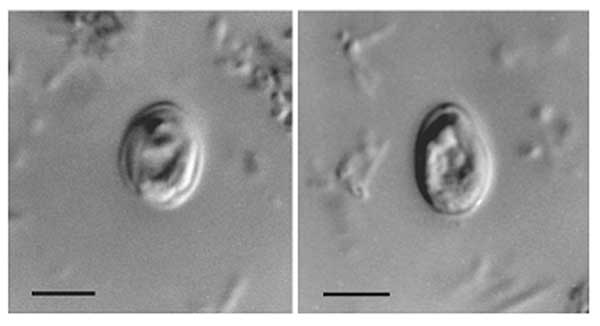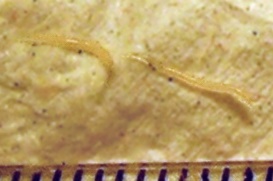|
Soil-transmitted Helminths
The soil-transmitted helminths (also called geohelminths) are a group of intestinal parasites belonging to the phylum Nematoda that are transmitted primarily through contaminated soil. They are so called because they have a direct life cycle which requires no intermediate hosts or vectors, and the parasitic infection occurs through faecal contamination of soil, foodstuffs and water supplies. The adult forms are essentially parasites of humans, causing soil-transmitted helminthiasis (STH), but also infect domesticated mammals. The juveniles are the infective forms and they undergo tissue-migratory stages during which they invade vital organs such as lungs and liver. Thus the disease manifestations can be both local and systemic. The geohelminths together present an enormous infection burden on humanity, amounting to 135,000 deaths every year, and persistent infection of more than two billion people. Types Soil-transmitted helminths are typically from the following families of ... [...More Info...] [...Related Items...] OR: [Wikipedia] [Google] [Baidu] |
Intestinal Parasite
An intestinal parasite infection is a condition in which a parasite infects the gastro-intestinal tract of humans and other animals. Such parasites can live anywhere in the body, but most prefer the intestinal wall. Routes of exposure and infection include ingestion of undercooked meat, drinking infected water, fecal-oral transmission and skin absorption. Some types of helminths and protozoa are classified as intestinal parasites that cause infection—those that reside in the intestines. These infections can damage or sicken the host (humans or other animals). If the intestinal parasite infection is caused by helminths, the infection is called helminthiasis. Signs and symptoms Signs and symptoms depend on the type of infection. Intestinal parasites produce a variety of symptoms in those affected, most of which manifest themselves in gastrointestinal complications and general weakness. Gastrointestinal conditions include inflammation of the small and/or large intestine, ... [...More Info...] [...Related Items...] OR: [Wikipedia] [Google] [Baidu] |
Ascarididae
The Ascarididae are a family of the large intestinal nematoda, roundworms. Members of the family are intestinal parasites, infecting all class (biology), classes of vertebrates. It includes a number of genus, genera,Anderson RC (2000)''Nematode Parasites of Vertebrates. Their Development and Transmission, 2nd ed.''CAB International, Wallingford, Oxon, UK, pp. 245-315. the most well known of which are: *''Amplicaecum'' *''Angusticaecum'' *''Ascaris'' *†''Ascarites'' (fossil)Poinar Jr, G. and Boucot, A. J. (2006) Evidence of intestinal parasites of dinosaurs. ''Parasitology'', 133: 245-249. *''Baylisascaris'' *''Crossophorus'' *''Dujardinascaris'' *''Hexametra'' *''Lagochilascaris'' *''Ophidascaris'' *''Parascaris'' *''Polydelphis'' *''Seuratascaris'' *''Toxascaris'' *''Toxocara'' *''Travassoascaris'' ''Ascaris lumbricoides'' is the main ascarid parasite of humans, causing ascariasis. References External links ZipcodeZoo [...More Info...] [...Related Items...] OR: [Wikipedia] [Google] [Baidu] |
Necatoriasis
Necatoriasis is the condition of infection by '' Necator'' hookworms, such as ''Necator americanus''. This hookworm infection is a type of helminthiasis (infection) which is a type of neglected tropical disease. Signs and symptoms When adult worms attach to the villi of the small intestine, they suck on the host's blood, which may cause abdominal pain, diarrhea, cramps, and weight loss that can lead to anorexia. Heavy infections can lead to the development of iron deficiency and hypochromic microcytic anemia. This form of anemia in children can give rise to physical and mental retardation. Infection caused by cutaneous larvae migrans, a skin disease in humans, is characterized by skin ruptures and severe itching. Cause Necatoriasis is caused by '' N. americanus''. ''N. americanus'' can be divided into two areas – larvae and adult stage. The third stage larvae are guided to human skin by following thermal gradients. Typically, the larvae enter through the hands and feet ... [...More Info...] [...Related Items...] OR: [Wikipedia] [Google] [Baidu] |
Ancylostomiasis
Ancylostomiasis is a hookworm disease caused by infection with Ancylostoma hookworms. The name is derived from Greek ancylos αγκύλος "crooked, bent" and stoma στόμα "mouth". Ancylostomiasis is also known as miner's anaemia, tunnel disease, brickmaker's anaemia and Egyptian chlorosis. Helminthiasis may also refer to ancylostomiasis, but this term also refers to all other parasitic worm diseases as well. In the United Kingdom, if acquired in the context of working in a mine, the condition is eligible for Industrial Injuries Disability Benefit. It is a prescribed disease (B4) under the relevant legislation.§ Ancylostomiasis is caused when hookworms, present in large numbers, produce an iron deficiency anemia by sucking blood from the host's intestinal walls. Signs and symptoms Depending on the organism, the signs and symptoms vary. ''Ancylostoma duodenale'' and ''Necator americanus'' can enter the blood stream while '' Ancylostoma braziliensis'' cannot. Signs and symp ... [...More Info...] [...Related Items...] OR: [Wikipedia] [Google] [Baidu] |
Hookworm Disease
Hookworm infection is an infection by a type of intestinal parasite known as a hookworm. Initially, itching and a rash may occur at the site of infection. Those only affected by a few worms may show no symptoms. Those infected by many worms may experience abdominal pain, diarrhea, weight loss, and tiredness. The mental and physical development of children may be affected. Anemia may result. Two common hookworm infections in humans are ancylostomiasis and necatoriasis, caused by the species ''Ancylostoma duodenale'' and ''Necator americanus'' respectively. Hookworm eggs are deposited in the stools of infected people. If these end up in the environment, they can hatch into larvae (immature worms), which can then penetrate the skin. One type can also be spread through contaminated food. Risk factors include walking barefoot in warm climates, where sanitation is poor. Diagnosis is by examination of a stool sample with a microscope. The disease can be prevented on an individual l ... [...More Info...] [...Related Items...] OR: [Wikipedia] [Google] [Baidu] |
Ascariasis
Ascariasis is a disease caused by the parasitic roundworm ''Ascaris lumbricoides''. Infections have no symptoms in more than 85% of cases, especially if the number of worms is small. Symptoms increase with the number of worms present and may include shortness of breath and fever in the beginning of the disease. These may be followed by symptoms of abdominal swelling, abdominal pain, and diarrhea. Children are most commonly affected, and in this age group the infection may also cause poor weight gain, malnutrition, and learning problems. Infection occurs by ingestion of food or drink contaminated with ''Ascaris'' eggs from feces. The eggs hatch in the intestines, the larvae burrow through the gut wall, and migrate to the lungs via the blood. There they break into the alveoli and pass up the trachea, where they are coughed up and may be swallowed. The larvae then pass through the stomach for a second time into the intestine, where they become adult worms. It is a type of soil-tr ... [...More Info...] [...Related Items...] OR: [Wikipedia] [Google] [Baidu] |
Enterobius
The pinworm (species ''Enterobius vermicularis''), also known as threadworm (in the United Kingdom, Australia and New Zealand) or seatworm, is a parasitic worm. It is a nematode (roundworm) and a common intestinal parasite or helminth, especially in humans.Encyclopædia Britannica. The medical condition associated with pinworm infestation is known as pinworm infection (enterobiasis) Merriam-Webster: Enterobiasis (a type of helminthiasis) or less precisely as oxyuriasis in reference to the family Oxyuridae. Merriam-Webster: Oxyuriasis Other than human, ''Enterobius vermicularis'' were reported from bonnet macaque. Other species seen in primates include ''Enterobius buckleyi'' in Orangutan and ''Enterobius anthropopitheci'' in chimpanzee. ''Enterobius vermicularis'' is common in human children and transmitted via the faecal-oral route. Humans are the only natural host of ''Enterobius vermicularis''. ''Enterobius gregorii'', another human species is morphologically indistingui ... [...More Info...] [...Related Items...] OR: [Wikipedia] [Google] [Baidu] |
Strongyloides Stercoralis
''Strongyloides stercoralis'' is a human pathogenic parasitism, parasitic nematode, roundworm causing the disease strongyloidiasis. Its common name in the US is threadworm. In the UK and Australia, however, the term ''threadworm'' can also refer to nematodes of the genus ''Enterobius'', otherwise known as Pinworm (parasite), pinworms. The ''Strongyloides stercoralis'' nematode can parasitize humans. The adult parasitic stage lives in tunnels in the mucosa of the small intestine. The genus ''Strongyloides'' contains 53 species, and ''S. stercoralis'' is the type species. ''S. stercoralis'' has been reported in other mammals, including cats and dogs. However, it seems that the species in dogs is typically not ''S. stercoralis'', but the related species ''S. canis''. Non-human primates are more commonly infected with ''S. fuelleborni'' and ''S. cebus'', although ''S. stercoralis'' has been reported in captive primates. Other species of ''Strongyloides'' that are naturally parasitic ... [...More Info...] [...Related Items...] OR: [Wikipedia] [Google] [Baidu] |
Strongyloididae
Strongyloididae is a family of nematodes belonging to the order Rhabditida. Genera: * '' Leipernema'' Narayan Singh, 1976 * '' Parastrongyloides'' Morgan, 1928 * ''Strongyloides ''Strongyloides'' (from Greek ''strongylos'', round, + ''eidos'', resemblance), anguillula, or threadworm is a genus of small nematode parasites, belonging to the family Strongylidae, commonly found in the small intestine of mammals (particularl ...'' Grassi, 1879 References {{Taxonbar, from=Q2191022 Nematodes ... [...More Info...] [...Related Items...] OR: [Wikipedia] [Google] [Baidu] |
Necator Americanus
''Necator americanus'' is a species of hookworm (a type of helminth) commonly known as the New World hookworm. Like other hookworms, it is a member of the phylum Nematoda. It is an obligatory parasitic nematode that lives in the small intestine of human hosts. Necatoriasis—a type of helminthiasis—is the term for the condition of being host to an infestation of a species of ''Necator''. Since ''N. americanus'' and ''Ancylostoma duodenale'' (also known as Old World hookworm) are the two species of hookworms that most commonly infest humans, they are usually dealt with under the collective heading of " hookworm infection". They differ most obviously in geographical distribution, structure of mouthparts, and relative size. ''Necator americanus'' has been proposed as an alternative to ''Trichuris suis'' in helminthic therapy. Morphology This parasite has two dorsal and two ventral cutting plates around the anterior margin of the buccal capsule. It also has a pair of subdors ... [...More Info...] [...Related Items...] OR: [Wikipedia] [Google] [Baidu] |
Ancylostoma Duodenale
''Ancylostoma'' is a genus of nematodes that includes some species of hookworms. Species include: : ''Ancylostoma braziliense'', commonly infects cats, popularly known in Brazil as ''bicho-geográfico'' : ''Ancylostoma caninum'', commonly infects dogs : ''Ancylostoma ceylanicum'' : '' Ancylostoma duodenale'' : ''Ancylostoma pluridentatum'', commonly infects sylvatic cats : ''Ancylostoma tubaeforme'', infects cats along with other hosts See also * Ancylostomiasis * List of parasites (human) Endoparasites Protozoan organisms Helminths (worms) Helminth organisms (also called helminths or intestinal worms) include: Tapeworms Flukes Roundworms Other organisms Ectoparasites References {{Portal bar, Bio ... External links * Ancylostomatidae Rhabditida genera {{Rhabditida-stub ... [...More Info...] [...Related Items...] OR: [Wikipedia] [Google] [Baidu] |
Ancylostomatidae
The Ancylostomatidae are a family of worms that includes the hookworms. Genera of Ancylostomatidae * '' Agriostomum'' * ''Ancylostoma'' * ''Bunostomum'' * '' Cyclodontostomum'' * '' Galonchus'' * ''Monodontus'' * '' Necator'' * ''Uncinaria ''Uncinaria'' is a genus of nematode. The genus was circumscribed by Josef Aloys Frölich in 1789. Species include: * '' Uncinaria criniformis'' * '' Uncinaria lucasi'' * '' Uncinaria sanguinis'' * ''Uncinaria stenocephala ''Uncinaria s ...'' Habit The hookworms, ''Ancylostoma'' and ''Necator'', draw a plug of intestinal mucosa into their buccal capsule. The tissue is broken down and blood is rapidly pumped through the intestine of the nematode so that most of it goes undigested. Lifecycle The hookworms, ''Necator americanus'' and ''Ancylostoma duodenale'', hatch as first-stage juveniles within the soil and develop to an infective third-stage juvenile. Infection occurs by direct penetration through the skin of the host. Althoug ... [...More Info...] [...Related Items...] OR: [Wikipedia] [Google] [Baidu] |



.jpg)
